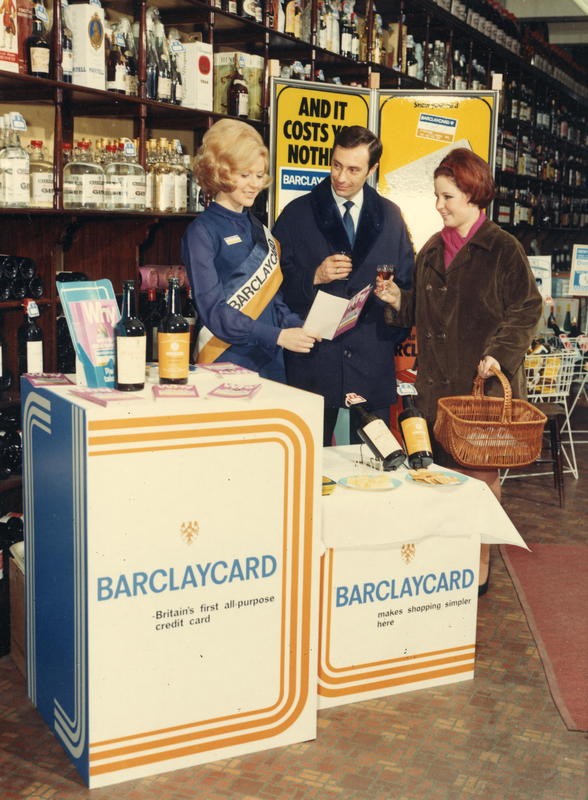Barclaycard

Barclaycard promotion, 1966 (ref 1159-0013)
Launched on 29 June 1966, Barclaycard was the first all-purpose credit card scheme to be operated by a British bank. Barclays set themselves the daunting task of recruiting 1,000,000 cardholders and 30,000 outlets by the launch date. A derelict shoe and boot factory in Northampton was converted in just two months into the main Barclaycard centre, whilst £500,000 was spent on advertising, and over 23 million forms were sent out to prospective customers.
Barclays adapted the computer programme used by the Bank of America for its BankAmericard system, launched in 1958, which was perhaps ironic as one of the major problems facing the bank was overcoming the attitude that credit cards were 'undesirable American influences.' Another problem that threatened the success of Barclaycard was the perception that the credit card was an inflationary system that encouraged people to spend money they did not have, which led to questions being asked in Parliament regarding the system. Despite these obstacles, and the sheer magnitude of the task, the UK’s first credit card was launched on time.
Credit limits were initially set at £100 and £200. A year after its launch, in 1967, Barclaycard became the first card to offer extended credit, whereby cardholders could budget their payments monthly. Interest was charged at 1.5% per month on the balance left 25 days after the statement was issued. Barclaycard was initially available in England, Wales and Scotland but 1967/68 saw expansion into Malta, Gibraltar and Ireland, and soon after, into South Africa, Japan, and the West Indies, all countries where Barclays had an established presence. Barclaycard also increased its sphere of influence by making reciprocal arrangements with foreign banks. From the start, there was an arrangement with Bank of America whereby Barclaycard was accepted by BankAmericard merchants and vice versa.
Other facilities introduced by Barclaycard included cheque encashment of up £30 available to customers of all banks in the British Isles in 1969, the raising of credit limits in 1971, and Barclaycard Masterloan, introduced in 1972. In 1974, Barclaycard became a dual-purpose card, in its role as both a credit card and a cheque guarantee card.
From the start, Barclaycard made use of modern advertising techniques, including colour supplement ads, customer mailings, and magazines. In 1968, an award-winning cinema film, 'Travelling Light', featured a woman with a card tucked into her bikini, demonstrating that a Barclaycard was all that you needed when out shopping.
In April 1977, Barclaycard underwent a major transformation with the introduction of the new Visa network symbol and the relegation of the signature strip to the reverse of the card. Despite these changes, the familiar blue, white and gold colour scheme was retained. 1977 also saw the re-launch of the Company Barclaycard. Originally launched in 1968, it was withdrawn in April 1975 due to a lack of interest. The new Company Barclaycard was more successful, and following refinements in 1984, has continued to be so to this day. The 1980s saw the redesign of Barclaycard to include the dove hologram and other security features in an effort to combat fraud, the introduction of Barclays Profiles, a customer incentive and loyalty scheme, and the launch of the Student Barclaycard.
The 1980s also saw much greater use of television advertisements, beginning with a campaign featuring Dudley Moore, followed by another starring Alan Whicker, which promoted Barclaycard as the traveller’s card. In June 1990, Barclaycard appointed a new advertising agency, BMP DDB Needham, who were responsible for the launch of the spoof spy commercials starring Rowan Atkinson, which won several TV advertising awards.
Barclaycard celebrated its 30th anniversary in June 1996 with the launch of a new design incorporating a ‘spinning’ card logo. The continuing commitment to providing customers with better services resulted in innovations such as the ‘smart’ card with a microchip to combat counterfeit fraud, a 24 hour one-stop travel shop, and Netlink. Introduced in 1995, Barclaycard Netlink was the first internet site to be launched by a UK financial services company which enabled customers to, among other services, pay their utility bills via the internet. By 1997, improvements meant that customers could check their Barclaycard statements and credit limit, and settle their bill online using a debit card.
The 1990s also saw the establishment of Barclaycard International, which led to direct expansion into several countries including Germany (1991), France (1998), Greece and Spain (1999), Botswana (2001), Italy (2002), and Portugal and Egypt (2004). Barclaycard is now present in over 20 countries. 2002 saw the start of Barclaycard Direct, providing mortgages, insurance and savings products, and of Nectar, a customer loyalty scheme in which customers could collect points through designated shops and services.
In 2004 Barclaycard was completely rebranded, with actress Jennifer Aniston, and, later, comedian Jennifer Saunders starring in the accompanying television adverts. In August 2000, Barclays acquired Juniper Financial Corporation, one of North America's fastest growing issuers, thereby gaining entry to the US credit card market, and in 2008, the Goldfish credit card business was purchased. Further acquisitions came with the Italian credit card business of Citibank in 2010, followed by Egg UK personal customers, and MBNA Europe’s small business portfolio in 2011.
Innovations have proceeded apace in recent years. In 2007, Barclaycard Breathe, the UK’s first environmentally-friendly credit card was launched, followed by Barclaycard OnePulse, the first contactless card in the UK in 2008. Contactless payment, which allows cardholders to make purchases of under £20 by simply holding their card over the receiving device, has been widely hailed for the convenience and speed it allows cardholders in making purchases, and Barclaycard Anywhere, launched in 2014, allows small and medium businesses to take card payments free from traditional point of sale areas with their mobile phone. Barclaycard continues to be at the forefront of banking innovation.